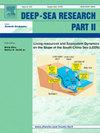The vertical profiles of the tidal constituents and bed-induced dissipation of tidal signals in the Persian Gulf
IF 3
3区 地球科学
Q2 OCEANOGRAPHY
Deep-sea Research Part Ii-topical Studies in Oceanography
Pub Date : 2025-08-07
DOI:10.1016/j.dsr2.2025.105528
引用次数: 0
Abstract
This study evaluates the hydrodynamic and tidal dynamics of the Persian Gulf using the Finite Volume Community Ocean Model (FVCOM) under two distinct forcing configurations: wind-and-tide and tide-only. A comprehensive statistical assessment was conducted to validate the model's performance in replicating tidal elevation and flow velocity against in-situ data as well as TPXO10 tidal predictions. Co-tidal maps revealed that semi-diurnal constituents (e.g., M2, S2) exhibit pronounced phase transitions, particularly at the Strait of Hormuz, highlighting the influence of regional bathymetry on tidal propagation. Diurnal constituents (e.g., K1, O1) showed more uniform phase distributions, suggesting reduced sensitivity to topographic constraints. The analysis of tidal amplitudes underscored the dominance of the M2 and K1 constituents. Vertical analyses of current speeds revealed distinct patterns of tidal attenuation between diurnal and semi-diurnal constituents. The diurnal constituents undergo greater amplitude reductions with depth compared to semi-diurnal constituents, indicating stronger bottom interaction processes for longer-period tides. While the M2 constituent demonstrated minimal sensitivity to wind forcing, diurnal constituents like K1 showed significant attenuation influenced by seasonal stratification and atmospheric conditions. These findings underscore the critical interplay between wind forcing, tidal dynamics, and seasonal variability in shaping the hydrodynamics of the Persian Gulf.
波斯湾潮汐成分的垂直剖面和潮汐信号的床致耗散
本研究利用有限体积群落海洋模型(FVCOM)在两种不同的强迫配置下(风-潮和仅潮)评估了波斯湾的水动力和潮汐动力学。利用实测数据和TPXO10潮汐预报数据,对模型在模拟潮汐高程和流速方面的性能进行了综合统计评估。共潮图显示,半日分量(如M2、S2)表现出明显的相变,特别是在霍尔木兹海峡,突出了区域测深对潮汐传播的影响。日组分(如K1, O1)表现出更均匀的相分布,表明对地形约束的敏感性降低。潮汐振幅的分析强调了M2和K1成分的优势。海流速度的垂直分析揭示了日和半日分量之间潮汐衰减的明显模式。与半日分量相比,日分量随深度的振幅减小幅度更大,表明长周期潮汐的底部相互作用过程更强。M2成分对风强迫的敏感性最小,而K1等日成分受季节分层和大气条件的影响呈显著衰减。这些发现强调了风强迫、潮汐动力学和季节变化在形成波斯湾流体动力学方面的关键相互作用。
本文章由计算机程序翻译,如有差异,请以英文原文为准。
求助全文
约1分钟内获得全文
求助全文
来源期刊
CiteScore
6.40
自引率
16.70%
发文量
115
审稿时长
3 months
期刊介绍:
Deep-Sea Research Part II: Topical Studies in Oceanography publishes topical issues from the many international and interdisciplinary projects which are undertaken in oceanography. Besides these special issues from projects, the journal publishes collections of papers presented at conferences. The special issues regularly have electronic annexes of non-text material (numerical data, images, images, video, etc.) which are published with the special issues in ScienceDirect. Deep-Sea Research Part II was split off as a separate journal devoted to topical issues in 1993. Its companion journal Deep-Sea Research Part I: Oceanographic Research Papers, publishes the regular research papers in this area.

 求助内容:
求助内容: 应助结果提醒方式:
应助结果提醒方式:


